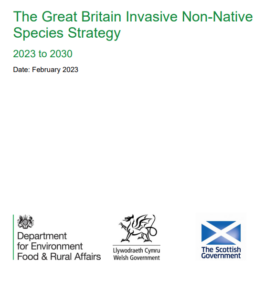
Defra has released a new invasive species strategy for Great Britain, highlighting a vision protect biodiversity, ecosystems, people and the economy and implement a partnership of government, voluntary organisations, NGOs, academia, businesses and the public.
The report highlights the likelihood that climate change will increase the problems caused by invasive species and sets out its aim to minimise the risk of introduction and establishment and reduce the negative impacts of invasive non-native species…..
The report highlights a variety of measures, roughly in line with the principles of prevention in health and safety – starting with avoiding the risks (preventing NNS from establishing in GB), evaluating risks and combatting risks at source, among other measures.
The report lists various successes of previous strategies, including:
- Eradication of four invasive animal species (African clawed toad, fathead minnow, American bullfrog and black bullhead)
- The Asian hornet contingency plan – which has resulted in a number of mobilisations to destroy Asian hornet nests in England and a total of twelve nests destroyed
- Eradications are still ongoing for two invasive plant species: water primrose and variable-leaved water milfoil. However, the report notes that complete eradications are lower than expected because of the level of available resources allocated to prevention, rather than eradication.
Other interesting points highlighted within the report include that:
- The report estimates the negative economic impact of non-native species as £1.9 billion, with the costs associated with Japanese knotweed estimated at £247 million per year.
- 10-15% of established non-native species in the UK cause significant adverse impacts, with these impacts classified as environmental, social or economic.
- 10-12 new non-native species become established in the UK each year (which suggests that every year, one or two new species are expected to establish in GB which cause significant negative impacts)
- DEFRA aims to increase action on the key species listed in the annexes of contingency plans – which includes kudzu, American watermilfoil and a couple of hogweed species – Persian hogweed and Sosnowski’s hogweed (which pose many of the same health risks as giant hogweed).
- There are over 50 Local Action Groups (LAGs) in GB working with volunteers to reduce the risks and impacts associated with INNS in their local area.
- Horizon scanning exercises by non-native species information portal (NNSIP) will continue – these exercises are to establish the species at risk of establishment in the UK and the risks associated with them.
- Biocontrol also gets a mention as a key tool for controlling some established species – as INNSA has frequently outlined, such programmes include biocontrol measures for Japanese knotweed, Himalayan balsam and floating pennywort.
- A significant portion of the report is dedicated to the goal of building awareness and understanding, including the ‘Check-Clean-Dry’ and ‘Be Plant Wise’ campaigns, and the annual Invasive Species Week (15th – 21st May 2023). The information sheets and other information available through the non-native species information portal on the GB NNSS website are valuable resources.
There are several points, however, on which INNSA feels the report either misses opportunities or falls short of the ideal, or misses opportunities to engage or take meaningful action.
It is noted that the report mentions the collective legislative framework and outlines that species of special concern must not be “intentionally brought into GB, kept, bred, sold, used or exchanged, allowed to reproduce, grown or cultivated, or released into the environment within GB, or transported to, from or within GB” – however, there is no information about prosecutions or other enforcement action actually taken. While INNSA welcomes regulation being in place, without effective enforcement, this will only affect those companies who are interested in following the rules; not rogue actors.
Sadly, established species are somewhat under-reported in the strategy, so far as this author is concerned. The extensive work being done by our industry is perhaps under-represented within the report as a whole.
It is welcome that the report states that “collaboration and partnership between government bodies, non-government organisations and industry is fundamental to achieving our vision.”, however, there is little clear indication within the report of how this should be achieved and what it actually means.
While there is rightly significant mention of local action groups (LAGs) and case studies of the works they do, there is disappointingly little mention within the report of the contribution of private home owners, commercial companies and the work done by the invasive species remediation industry on their behalf.
The UK has one of the most developed, active and widespread invasive species remediation industries in the world and while the figures highlighted and framed within the report as the impacts of invasive species (e.g. the £247 million impact of Japanese knotweed) are entirely identified as “costs to the economy”, significant portions of these figures represent spending on programmes of invasive species remediation, which, in a strategy for managing invasive species should be identified as opportunities.
While resources are, of course, an issue and LAGs are a great way to get more bang for the government’s buck, the opportunities for coordinating works with landowners and invasive species remediation companies seem to be a significant oversight from this strategy – effectively making hundreds of millions in funding available, if the opportunities were taken to coordinate works more effectively.
INNSA will work to develop such opportunities over the coming years and welcomes contributions not only from members but from end users, volunteers and other interest groups.
